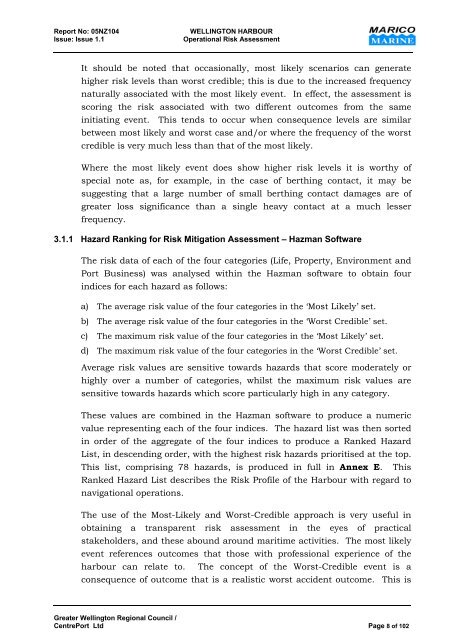MARICO Marine NZ Limited WELLINGTON HARBOUR PORT AND ...
MARICO Marine NZ Limited WELLINGTON HARBOUR PORT AND ...
MARICO Marine NZ Limited WELLINGTON HARBOUR PORT AND ...
Create successful ePaper yourself
Turn your PDF publications into a flip-book with our unique Google optimized e-Paper software.
Report No: 05<strong>NZ</strong>104 <strong>WELLINGTON</strong> <strong>HARBOUR</strong><br />
Issue: Issue 1.1 Operational Risk Assessment<br />
It should be noted that occasionally, most likely scenarios can generate<br />
higher risk levels than worst credible; this is due to the increased frequency<br />
naturally associated with the most likely event. In effect, the assessment is<br />
scoring the risk associated with two different outcomes from the same<br />
initiating event. This tends to occur when consequence levels are similar<br />
between most likely and worst case and/or where the frequency of the worst<br />
credible is very much less than that of the most likely.<br />
Where the most likely event does show higher risk levels it is worthy of<br />
special note as, for example, in the case of berthing contact, it may be<br />
suggesting that a large number of small berthing contact damages are of<br />
greater loss significance than a single heavy contact at a much lesser<br />
frequency.<br />
3.1.1 Hazard Ranking for Risk Mitigation Assessment – Hazman Software<br />
The risk data of each of the four categories (Life, Property, Environment and<br />
Port Business) was analysed within the Hazman software to obtain four<br />
indices for each hazard as follows:<br />
a) The average risk value of the four categories in the ‘Most Likely’ set.<br />
b) The average risk value of the four categories in the ‘Worst Credible’ set.<br />
c) The maximum risk value of the four categories in the ‘Most Likely’ set.<br />
d) The maximum risk value of the four categories in the ‘Worst Credible’ set.<br />
Average risk values are sensitive towards hazards that score moderately or<br />
highly over a number of categories, whilst the maximum risk values are<br />
sensitive towards hazards which score particularly high in any category.<br />
These values are combined in the Hazman software to produce a numeric<br />
value representing each of the four indices. The hazard list was then sorted<br />
in order of the aggregate of the four indices to produce a Ranked Hazard<br />
List, in descending order, with the highest risk hazards prioritised at the top.<br />
This list, comprising 78 hazards, is produced in full in Annex E. This<br />
Ranked Hazard List describes the Risk Profile of the Harbour with regard to<br />
navigational operations.<br />
The use of the Most-Likely and Worst-Credible approach is very useful in<br />
obtaining a transparent risk assessment in the eyes of practical<br />
stakeholders, and these abound around maritime activities. The most likely<br />
event references outcomes that those with professional experience of the<br />
harbour can relate to. The concept of the Worst-Credible event is a<br />
consequence of outcome that is a realistic worst accident outcome. This is<br />
Greater Wellington Regional Council /<br />
CentrePort Ltd Page 8 of 102
















